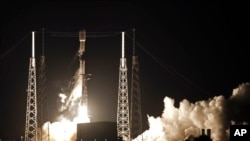SpaceX says a geomagnetic storm brought down 40 satellites launched last Thursday as part of its Starlink satellite internet service.
In a release posted to the company’s website, the private space company said the satellites were among 49 Starlink satellites launched from the Kennedy Space Center, and that they were deployed to their intended orbit 210 kilometers above Earth.
The company explained it deploys its satellites into lower orbits so that, in the event they do not pass initial system checkouts, it can quickly and safely bring them out of orbit by atmospheric drag.
But SpaceX says the satellites were significantly impacted by a geomagnetic storm on Friday. The National Oceanic and Atmospheric Administration's ((NOAA)) Space Weather Prediction Center had posted a watch late last week for minor to moderate geomagnetic storm activity.
The company said the storms cause the atmosphere to warm and increase its density at altitudes where the satellites are deployed. SpaceX reports GPS readings on the satellites suggests the storm increased atmospheric drag 50 percent higher than normal.
The SpaceX ground control team set the satellites into a “safe-mode,” changing their flight attitude to minimize drag to effectively “take cover from the storm.”
The company says its preliminary analysis shows the increased drag at the low altitudes prevented the satellites from leaving safe mode and they failed to return to their intended orbits. It said 40 will reenter or already have reentered Earth’s atmosphere.
The company says the satellites pose no collision risk with other ones and are designed to disintegrate upon re-entering the atmosphere with no orbital debris expected to hit the ground.
SpaceX has launched nearly 2,000 satellites as part of a network to provide high-speed internet service to users anywhere in the world. Service in the northern United States and Canada is expected to start later this year.





